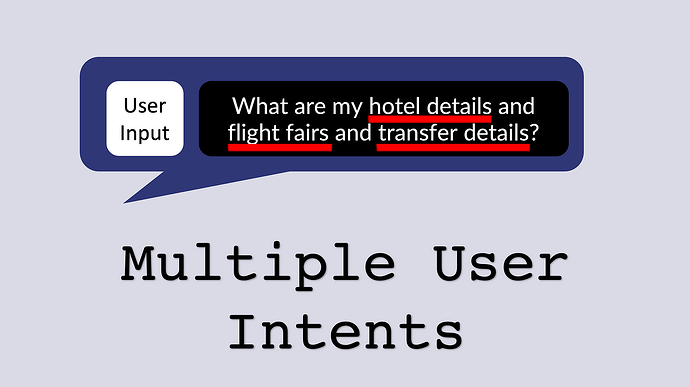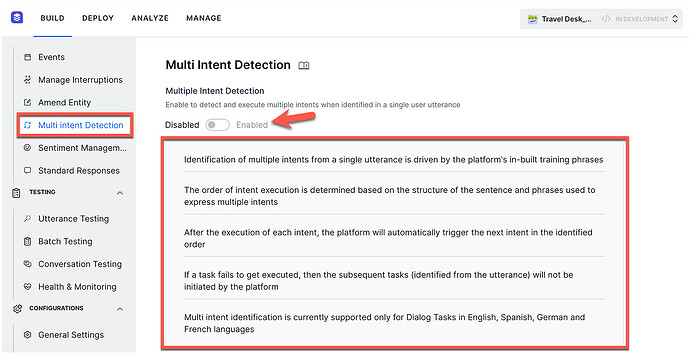The Problem Of Multiple Intent Detection & How Kore.ai Is Solving For This
Users do not always speak in single intent utterances…and voicebots are especially susceptible to more verbose input.
When it comes to Digital Assistants, users do not necessarily speak in single intent utterances…for example…
![]() “What are my hotel reservation details.”
“What are my hotel reservation details.”
![]() “Please give me my flight fairs.”
“Please give me my flight fairs.”
![]() “What are my transfer details again?”
“What are my transfer details again?”
A user will most probably combine multiple intents in one utterance, like the example below:
![]() “Regarding my trip, I need hotel reservations, flight fairs and transfers please?”
“Regarding my trip, I need hotel reservations, flight fairs and transfers please?”
Keep in mind that voicebots or speech interfaces lead to more verbose user input. Users tend to speak longer and utter multiple intents…
There are basically three ways of managing multi-intent user input…
![]() Use visual design affordances like buttons, drop-down menus, etc to restrict and direct user dialog. This option is highly dependant on the medium in use; for instance WhatsApp has much less design affordances than Messenger, etc.
Use visual design affordances like buttons, drop-down menus, etc to restrict and direct user dialog. This option is highly dependant on the medium in use; for instance WhatsApp has much less design affordances than Messenger, etc.
![]() Make use of disambiguation menus and mandate a user to select a single intent to continue the dialog with.
Make use of disambiguation menus and mandate a user to select a single intent to continue the dialog with.
![]() Implement routines where the user input is parsed and intents are ranked according to confidence scores. These confidence scores need to be used to create a conversational flow where the intents are addressed in a sequential way.
Implement routines where the user input is parsed and intents are ranked according to confidence scores. These confidence scores need to be used to create a conversational flow where the intents are addressed in a sequential way.
These approaches won’t scale well for growing and complex implementations as the settings will have to be implemented, maintained and managed across the conversational landscape.
How Is Kore.ai automating Multi-Intent User Input?
Kore AI has a feature called “Multi Intent Detection”. This feature can be toggled on and off, when enabled it allows for the detection and execution of multiple intents identified in a single user input.
Five key fixed settings are given within the “Multi Intent Detection” view, these five setting descriptions are currently static or fixed, and cannot be tweaked or fine-tuned.
![]() Below are a few ideas on how these five key fixed settings can be made intelligent thus allowing for more granular management of multiple intent detection.
Below are a few ideas on how these five key fixed settings can be made intelligent thus allowing for more granular management of multiple intent detection.
Kore AI Static Rule 
Identification of multiple intents from a single utterance is driven by the platform's in-built training phrases
Kore AI Static Rule 
The order of intent execution is determined based on the structure of the sentence and phrases used to express multiple intents
Kore AI Static Rule 
After the execution of each intent, the platform will automatically trigger the next intent in the identified order
Kore AI Static Rule 
If a task fails to get executed, then the subsequent tasks (identified from the utterance) will not be initiated by the platform
Kore AI Static Rule 
Multi intent identification is currently supported only for Dialog Tasks in English, Spanish, German and French languages
 Multiple Intent Management Example
Multiple Intent Management Example
Below is a two-intent example from Kore AI, the user asks about
![]() hotel details and
hotel details and
![]() flight fairs,
flight fairs,
Both items are presented to the user in sequence, and again it needs to be mentioned that some contextual message will help the conversational flow.
Lastly, here is an example with three user intents, and the response from Kore AI…
 User Input:
User Input:
hotel details and flight fairs and transfer details
 The Conversational Interface’s Response:
The Conversational Interface’s Response:
I’m currently the Chief Evangelist @ Kore.ai. I explore and write about all things at the intersection of AI and language; ranging from LLMs, Chatbots, Voicebots, Development Frameworks, Data-Centric latent spaces and more.



